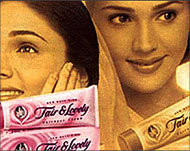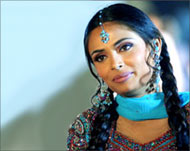What Percent Of India Is Dark Skinned
The sun shines bright here throughout the year – except in the snow-capped Himalayan region – and two of the virtually revered Hindu deities, Krishna and Shiva, are the colour of a beautiful night heaven, non to mention the religion's supreme goddess Kali (meaning black).
If blackness still connotes blemish rather than beauty in Bharat, the reasons, say experts, are historical and political.
Social indicators
"Colour prejudice is an offshoot of the bigger evil of casteism in Bharat," says Udit Raj, leader of the Indian Justice Party, which represents Dalits or the oppressed tribes and castes in the traditional political arrangement.
 |
| Indian Justice Party president |
"The hold of the caste system in India is deep, dark skin is the peel of the lowest castes, traditionally the subjugated people and, therefore, disagreeable," he says.
The country'south strange rulers, whether Mughal or British, were also lite-skinned. This, says the Dalit leader, has contributed to shaping social attitudes in India.
"Fair skin became a symbol of power and wealth and those who equate beauty with it are subconsciously hankering after a college status; those who are shunning black are, possibly, rejecting the slavery that it connotes whether in India or in the U.s.."
Religious influence
Ideally, the Hindu religion should have gifted the boilerplate Indian a great beloved for blackness, and not only considering the most loved Hindu gods are this colour, says Baba Goswami, 78-twelvemonth-former Hindu leader of a Krishna cult, the Westward Bengal-based Gaurang Ashram.
"While white is the color of light and purity, black, like the dark, connotes a dissolution of all form." says Baba Goswami, who, however, agrees that such "profound interpretations" are beyond the average person'southward understanding, which is why, "despite the deep hold of organized religion on the Indian mind there is colour prejudice in society."
 |
| An Indian thespian plays the part of |
Udit Raj, who, like many Dalits, converted to Buddhism, believes that Hindu organized religion has reinforced rather than removed racial prejudice in the country, generally "through the evil of casteism."
Likewise, "only a few of the 33 million gods are dark, the rest are all fair," he points out.
The story of Ramayana, the most pop Indian ballsy, he underlines, is "all most the victory of blanched and noble Ram over the black and evil Ravana."
What religious and political leaders find most alarming nearly this subtle racism in Bharat is that already disadvantaged groups similar women, tribal and lower degree people are caught in its vortex.
Fair and foul
Matrimonial advertisements, pinnacle revenue earners of many Indian newspapers, are nothing if not a report in colour prejudice of the Indian middle class: 90 out of 100 matrimonial ads list a woman's "fair," "very fair" and "really fair" pare equally a prerequisite to her acceptance as a "beautiful" woman.
"I am very nighttime, almost black, but my wife is as fair equally an English adult female and I must say that … I found her fair skin very bonny"
Udit Raj
Indian Justice party leader
The colour prejudice is so infectious that, Dalits, officially categorised equally Scheduled Castes and Tribes, who are amidst the almost nighttime-skinned people in the country, are also seeking fair brides. Fifty-fifty their pol pleads guilty to it.
"I am very dark, almost black, but my wife is as fair equally an English woman and I must say that although ours was a love matrimony in which her intrinsic qualities mattered more than looks, I plant her fair pare very attractive," says Udit Raj.
In his view, while preference for fair skin may be natural, the prejudice against dark pare in Bharat is cultivated.
Folklore about feminine beauty largely celebrates black tresses and kohl eyes, but the pare had better be fair for a woman to authorize as truly cute.
Peel-lightening agents, whether herbal or chemical, are the everyman common denominator in 95% of the ethnic dazzler products like soaps and creams.
Marketing campaigns
 |
| Advertisement campaign by |
The fairness cream industry rakes in about $150 million in sales annually, according to a Mumbai-based marketing enquiry group, ORG-MARG.
Taking a leaf out of this dazzler book, a cosmetic company, Hindustan Lever Limited (HLL), the Indian subsidiary of the London-based Unilever, launched a television ad campaign last twelvemonth in which a dark-skinned, plain Jane, unable to comport the financial responsibility of her family unit, is undergoing deep mental trauma until she finds a "fairness foam."
The cream transforms her into a gorgeous, lite-skinned adult female and her looks get her passport to a successful career as a mini skirt-clad flight attendant.
The ad campaign went unnoticed for its securely sexist and racist tone until a feminist group decided to practise something nigh information technology.
That the leftist All Republic of india Democratic Women's Alliance (AIDWA) had to petition the National Man Rights Commission (NHRC) before HLL withdrew the campaign earlier this year tells its own story about the difficult shell that protects such attitudes in India.
The NHRC is an autonomous torso whose chairperson and members include eminent judges and bureaucrats appointed by the President of India and information technology was the first such complaint before it.
Cheers to the commission, the feminists' battle against the cosmetic visitor ended in victory but the war on colour prejudice, information technology seems, has not even begun.
Obstacles
Even famous people complain about colour barriers.
"I was thin, a adult female and dark—three features that are not adequate to the people of Kerala"
Arundhati Roy
author and social activist
"I was thin, a woman AND dark —iii features that are not adequate to the people of Kerala," celebrated author-activist Arundhati Roy said in a media interview presently after she won Uk's prestigious Booker Prize for her volume, 'God of Minor Things.'
Underscoring the irony in Roy'due south ascertainment is the fact that Kerala is a matriarchal social club where an overwhelming majority of the population are dark-skinned.
While some in India may disagree with this assessment, the fact remains that criticism past those on the receiving end of what is considered to be colour prejudice indicate the existence of problematic social attitudes.
Bollywood's dark undercover
 |
| Bollywood actress Sheen: Pare |
Way models like Nina Emmanuel, Nayanka Chatterjee and Sheetal Malhar all know that their brown-black peel is a disadvantage.
They are far less in demand in India than the blanched models, and have to scout the Western mode capitals to brand coin and proper name.
"At least the manner industry has reached a stage of evolution where colour is an result and those at a disadvantage because of it openly talk virtually it," says film critic Shubhra Gupta.
"In Bollywood, where fair and cute go hand in mitt, you lot are either fair or you won't even dream of getting the leading lady'southward role," she says.
"A nighttime-skinned actress, on the other mitt, even to get a vamp'south role has to accept a voluptuous grade that she is prepare to bare," says Gupta about the racist accent of Bollywood, a nickname for the world's largest moving-picture show manufacture – of commercial Hindi movie theater.
Gupta attributes the success of Bollywood dark-skinned extra Bipahsa Basu to her bold and anarchistic roles where accent is on exposure rather than color of the pare.
Racial themes also detect an echo in mainstream Hindi cinema although the dialect today is less pronounced and more light-hearted than information technology was in the by.
"Dark skin is either the butt of jokes or when inter-linked with casteist-sexist themes it is a matter of tragedy, but it is never a normal characteristic and certainly not beautiful," emphasises Gupta.
Social and political activists would vouch that the same is true in real life, only far worse for the victims.
Source: https://www.aljazeera.com/news/2003/10/7/black-is-blemish-in-india
Posted by: langlaisalwaskess.blogspot.com

0 Response to "What Percent Of India Is Dark Skinned"
Post a Comment